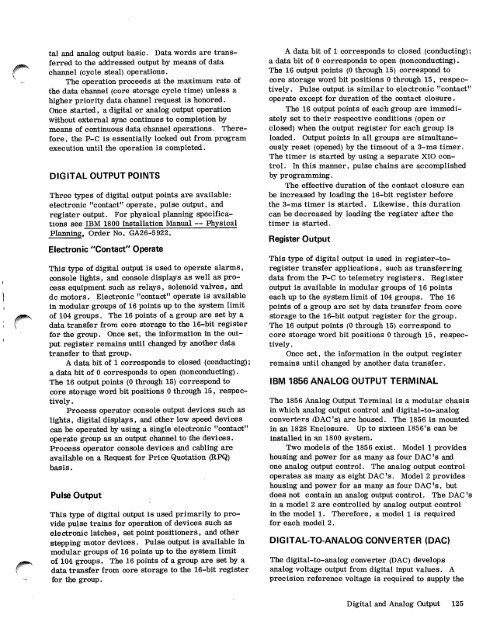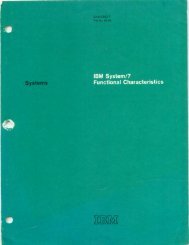Systems Reference Library - All about the IBM 1130 Computing ...
Systems Reference Library - All about the IBM 1130 Computing ...
Systems Reference Library - All about the IBM 1130 Computing ...
- No tags were found...
You also want an ePaper? Increase the reach of your titles
YUMPU automatically turns print PDFs into web optimized ePapers that Google loves.
tal and analog output basic. Data words are transferredto <strong>the</strong> addressed output by means of datachannel (cycle steal) operations.The operation proceeds at <strong>the</strong> maximum rate of<strong>the</strong> data channel (core storage cycle time) unless ahigher priority data channel request is honored.Once started, a digital or analog output operationwithout external sync continues to completion bymeans of continuous data channel operations. Therefore,<strong>the</strong> P-C is essentially locked out from programexecution until <strong>the</strong> operation is completed.DIGITAL OUTPUT POINTSThree types of digital output points are available:electronic "contact" operate, pulse output, andregister output. For physical planning specificationssee <strong>IBM</strong> 1800 Installation Manual -- PhysicalPlanning, Order No. GA26-5922.Electronic "Contact" OperateThis type of digital output is used to operate alarms,console lights, and console displays as well as processequipment such as relays, solenoid valves, andde motors. Electronic "contact" operate is availablein modular groups of 16 points up to <strong>the</strong> system limitof 104 groups. The 16 points of a group are set by adata transfer from core storage to <strong>the</strong> 16-bit registerfor <strong>the</strong> group. Once set, <strong>the</strong> information in <strong>the</strong> outputregister remains until changed by ano<strong>the</strong>r datatransfer to that group.A data bit of 1 corresponds to closed (conducting);a data bit of 0 corresponds to open (nonconducting).The 16 output points (0 through 15) correspond tocore storage word bit positions 0 through 15, respectively.Process operator console output devices such aslights, digital displays, and o<strong>the</strong>r low speed devicescan be operated by using a single electronic "contact"operate group as an output channel to <strong>the</strong> devices.Process operator console devices and cabling areavailable on a Request for Price Quotation (RPQ)basis.Pulse OutputThis type of digital output is used primarily to providepulse trains for operation of devices such aselectronic latches, set point positioners, and o<strong>the</strong>rstepping motor devices. Pulse output is available inmodular groups of 16 points up to <strong>the</strong> system limitof 104 groups. The 16 points of a group are set by adata transfer from core storage to <strong>the</strong> 16-bit registerfor <strong>the</strong> group.A data bit of 1 corresponds to closed (conducting);a data bit of 0 corresponds to open (nonconducting).The 16 output points (0 through 15) correspond tocore storage word bit positions 0 through 15, respectively.Pulse output is similar to electronic "contact"operate except for duration of <strong>the</strong> contact closure.The 16 output points of each group are immediatelyset to <strong>the</strong>ir respective conditions (open orclosed) when <strong>the</strong> output register for each group isloaded. Output points in all groups are simultaneouslyreset (opened) by <strong>the</strong> timeout of a 3-ms timer.The timer is started by using a separate XIO control.In this manner, pulse chains are accomplishedby programming.The effective duration of <strong>the</strong> contact closure canbe increased by loading <strong>the</strong> 16-bit register before<strong>the</strong> 3-ms timer is started. Likewise, this durationcan be decreased by loading <strong>the</strong> register after <strong>the</strong>timer is started.Register OutputThis type of digital output is used in register-toregistertransfer applications, such as transferringdata from <strong>the</strong> P-C to telemetry registers. Registeroutput is available in modular groups of 16 pointseach up to <strong>the</strong> system limit of 104 groups. The 16points of a group are set by data transfer from corestorage to <strong>the</strong> 16-bit output register for <strong>the</strong> group.The 16 output points (0 through 15) correspond tocore storage word bit positions 0 through 15, respectively.Once set, <strong>the</strong> information in <strong>the</strong> output registerremains until changed by ano<strong>the</strong>r data transfer.<strong>IBM</strong> 1856 ANALOG OUTPUT TERMINALThe 1856 Analog Output Terminal is a modular chasisin which analog output control and digital-to-analogconverters (DAC's) are housed. The 1856 is mountedin an 1828 Enclosure. Up to sixteen 1856's can beinstalled in an 1800 system.Two models of <strong>the</strong> 1856 exist. Model 1 provideshousing and power for as many as four DAC 's andone analog output control. The analog output controloperates as many as eight DAC 's. Model 2 provideshousing and power for as many as four DAC 's, butdoes not contain an analog output control. The DAC 'sin a model 2 are controlled by analog output controlin <strong>the</strong> model 1. Therefore, a model 1 is requiredfor each model 2.DIGITAL-TO-ANALOG CONVERTER (DAC)The digital-to-analog converter (DAC) developsanalog voltage output from digital input values. Aprecision reference voltage is required to supply <strong>the</strong>Digital and Analog Output 125
















